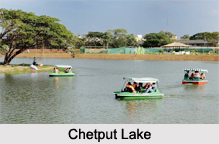 Chetput Lake is located in the Indian state of a Tamil Nadu. More specifically, this lake is situated to the north of Chetput Railway Station in Chennai. It is considered to be the only existing lake at the centre of the city. The managing body of this lake is the Department of Fisheries of the Government of Tamil Nadu.
Chetput Lake is located in the Indian state of a Tamil Nadu. More specifically, this lake is situated to the north of Chetput Railway Station in Chennai. It is considered to be the only existing lake at the centre of the city. The managing body of this lake is the Department of Fisheries of the Government of Tamil Nadu.
Geography of Chetput Lake
Chetput Lake has a surface area of about 15 acres. As per estimations, this lake is about18 feet deep. An anglers club was functioning till the 1940s in the lake, whose members visited the small island in the midst of the water body for fishing.
Fauna of Chetput Lake
The water of Chetput Lake is not saline. Owing to this factor, the lake supports the survival of few varieties of fishes such as rohu, catla and mrigal.
Utilization of Chetput Lake
The lake functioned as a source of groundwater recharge for the surrounding areas, but it could not act as a source of drinking water.
Threat to Chetput Lake and it"s Rejuvenation
Uncontrolled activities in terms of heavy encroachment, particularly near the Chetpet Railway Station had adversely affected the quality of Chetput Lake.
Since the mid-1990s plans were being made to rejuvenate Chetpet Lake in terms of a boat club, an aquarium, seafood stall and fish court besides a walkway around the water body. In 2005, the Chetput Lake was selected apart from 12 other lakes of Greater Chennai area for an eco-restoration project. A detailed survey was conducted by the CPR Environmental Education Centre. Consequently, the state government entrusted the Tamil Nadu Urban Infrastructure Finance Services Limited with the responsibility to prepare a project report. The State Government then had sanctioned near about 4 million to clean the overgrown water hyacinth and de-silt the lake in 2007-2008. In order to construct a 1,475-m-long stormwater drain from the lake to the Cooum River, the Chennai Corporation Council adopted a resolution in May, 2012. The amount sanctioned for the construction of this drain was near about 22.9 million. The drain was designed to pass through the New Bhoopathy Nagar, Pachaiappa`s College play ground and Venkatachalapathy Street. This arrangement would prevent monsoons.
Development of Chetput Lake
Development of Chetput Lake was announced in April 2013 by the Chief Minister of Tamil Nadu, J. Jayalalithaa. Accordingly, the lake would then have facilities for angling, water sports, boating and open-air auditoriums. The amount sanctioned for this development was near about 420 million. An eco park was also planned on the lake shore. This park would occupy an area of about 15-acres, adjoining the lake. It would be provided with tracks for walkers and joggers, children`s play area, a seafood restaurant and multilevel parking space to accommodate 200 cars. The eco park was planned to have an elevated link with Chetpet railway station. The park would also be connected to Poonamallee High Road via infrastructure. In June 2014, the foundation stone for the park was laid. To connect the lake with Cooum River near Spur Tank Road, construction of a box culvert beneath the railway tracks was also planned.
In order to house a stall of the Fisheries Development Corporation, a building is also planned to be constructed in the side of the lake. The amount sanctioned for the said purpose is about 60 million. It would be a three-storied building housing the offices of the Tamil Nadu Fisheries Development Corporation, Tamil Nadu State Apex Fisheries Cooperative Federation and the chief engineer of the fisheries department. This building would also have two fish heads joined by a fin and a tail. Light-weight material would be used to develop these heads that would be facing north and west.
Related Articles:
Water Resources in India
Lakes of India
Indian Rivers
Dams in India
Estuaries of India



















